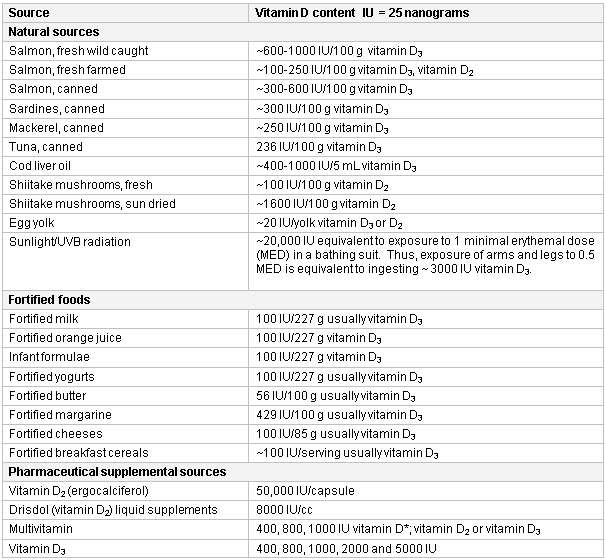Primary prevention
It is difficult to obtain an adequate amount of vitamin D from dietary sources alone (both natural sources and vitamin D-fortified foods).[11] Therefore, a combination of sensible sun exposure along with adequate vitamin D supplementation for all children and adults will prevent vitamin D deficiency/insufficiency in the general population. However, for a variety of reasons, even in the sunniest parts of the globe, including the Middle East, India, Colombia, Mexico, Brazil, and Australia, vitamin D deficiency and insufficiency is common because of inadequate sun exposure.[58] The amount of sun exposure required depends on time of day, season, latitude (vitamin D cannot be made in the winter unless you are below a latitude of about 35°), and skin pigment.[58][71] There are smartphone apps available that can provide advice about sensible sun exposure, give information about how much vitamin D is being made in the skin during current sun exposure, and alert the user when to stop the exposure to prevent sunburn.
Recommendations on daily intake lack consensus:
Although the World Health Organization does not recommend supplementation for all pregnant women, if vitamin D deficiency is suspected (such as women in populations where sun exposure and dietary vitamin D is limited), vitamin D supplements may be given at the current recommended nutrient intake of 200 IU/day.[72]
From birth and throughout childhood the American Academy of Pediatrics recommends 400 IU vitamin D/day.[73]
The Institute of Medicine (IOM) recommends infants 0-12 months receive 400 IU vitamin D/day and children ≥1 year and adults receive 600 IU/day.[74] Furthermore, the IOM recommended the upper limit of vitamin D for infants 0-6 months and 6-12 months at 1000 and 1500 IU/day, respectively. The upper limit was increased to 2500 IU/day for children aged 1-3 years, and 3000 IU/day for 4-8 years. For children aged >8 years and adults, the upper limit was raised to 4000 IU/day.[74]
The 2011 Endocrine Society practice guidelines on vitamin D recommend that infants to 1 year of age should receive 400-1000 IU/day, children aged 1-18 years 600-1000 IU/day, and adults of normal body weight 1500-2000 IU/day.[2]
In the UK, individuals who are at risk of vitamin D deficiency are advised to take 400 IU vitamin D/day (reduce dose if age <4 years).[75] Specific populations at risk of vitamin D deficiency are: pregnant and breast-feeding women; infants and children ages under 4 years; adults ages 65 years or above; those with limited exposure to the sun (e.g., if they cover their skin for cultural reasons or are housebound); and women and children of Asian origin.[76]
In a normal-weight adult, for every 100 IU vitamin D ingested, the serum level of 25-hydroxyvitamin D increases by approximately 1 nanogram/mL.[77] Therefore, to achieve a serum level of 25-hydroxyvitamin D of >30 nanograms/mL, 2000-3000 IU vitamin D/day is required. Obese adults (BMI >30) require two to three times the normal recommended daily dose to achieve the same level.[1][2]
[Figure caption and citation for the preceding image starts]: Sources of vitamin DCreated by M.F. Holick, PhD, MD; used with permission [Citation ends].
Secondary prevention
Once the desired serum concentration of 25-hydroxyvitamin D is obtained (at least 30 nanograms/mL and preferably 40-60 nanograms/mL), daily oral vitamin D maintenance dose is initiated and should be continued for life to prevent a recurrence.[2] Lactating women may need to take as much as 4000 to 6000 IU daily to satisfy their infant's vitamin D requirement. Obese adults require two to three times more vitamin D due to the body fat diluting the vitamin D. In addition dietary sources, including wild caught salmon, sun dried mushrooms and vitamin D fortified foods, as well as outdoor sensible sun exposure, are also helpful in preventing vitamin D deficiency.
Use of this content is subject to our disclaimer